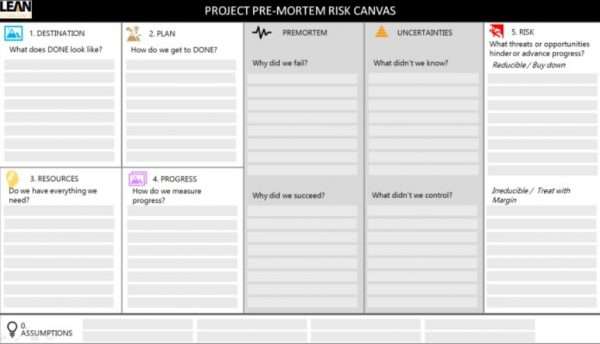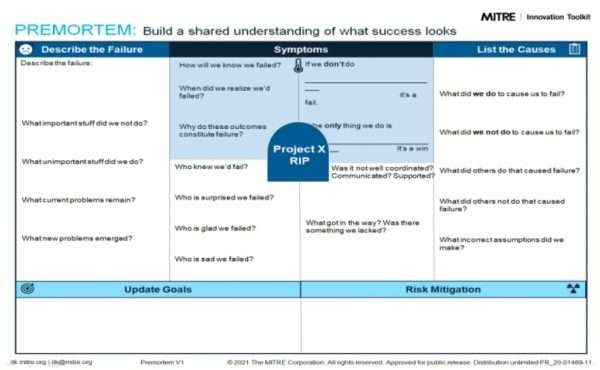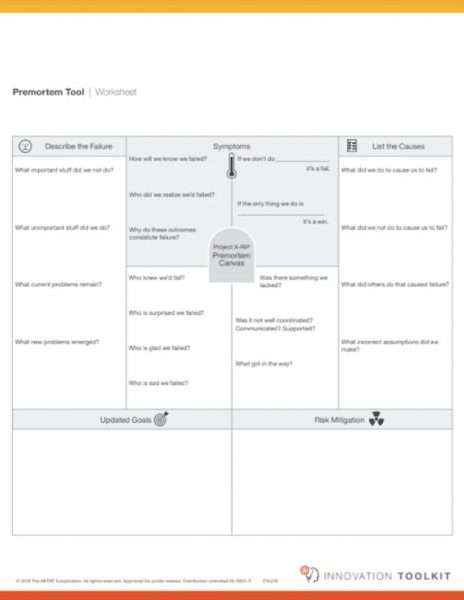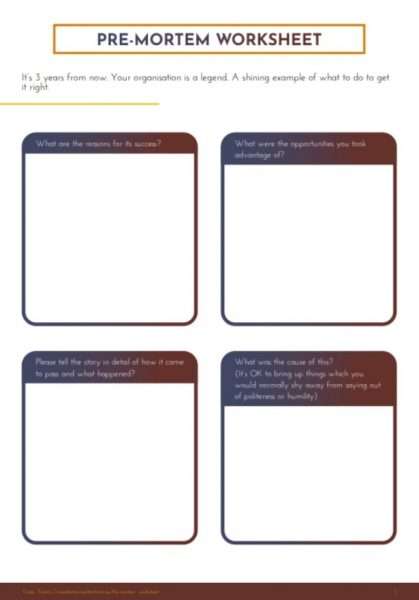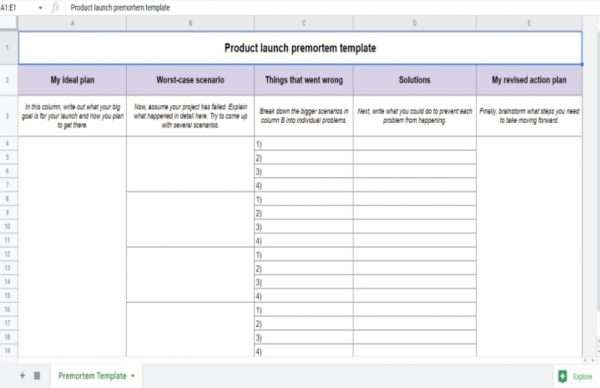A pre-mortem template is a risk management method and was developed by Gary Klein in 2007. Instead of finding out what went wrong, the team analyzes what could go wrong. Then you work back and make a plan to keep potential issues from harming your project. The objective is to increase the probability of project success by discussing failure points upfront.
In business, a postmortem refers to project analysis. It means an understanding of what didn’t go well and what went well so you can have the lessons learned for the next projects.
Mortem means “death”. When someone dies, a pathologist performs a postmortem to discover the cause of death. The pathologist learns about things from the postmortem that may prevent future deaths.
Pre-mortem vs Retrospective
Pre-mortem and retrospective are not mutually exclusive. They serve a purpose in leading projects. A project management agile retrospective dissects the project and discovers what went wrong, so the same results can be avoided in the next project. The difference is that the premortem is a failure before the start of the project and a postmortem is done after the project is closed.
A retrospective doesn’t mean that the project has failed. It may have, but a retrospective may also follow a successful closing of a project. That’s because projects have their share of misadventures and wrong turns, which are examined by a postmortem to find out how to avoid the same mistakes in the future.
Together, a retrospective and a premortem are useful tools to understand the underlying currents of a project and how they carry it. The more the knowledge of factors that tick the project, the more likely it can be run clockwise.

A premortem analysis involves discovering the factors that may result in project failure to avoid potential issues and anticipate risks. It allows one to learn from mistakes and increases the chances of eliminating them at the start of the project. This excel template can be used for large and small projects and includes a chart for an action plan to mitigate risks.
Pre-mortem Template PowerPoint
Identify failure drivers and examine the cause by using these premortem PowerPoint templates. Discuss whether the team is mitigating the cause of project failure by taking appropriate steps.
Explore and frame your project problem by discovering future scenarios in which the activity might fail from achieving its objectives, identifying the failure causes, and describing the failure. Provide insight to your team about the success criteria and priorities, identify pitfalls, and uncover assumptions by using this template.
Why should you do a premortem analysis?
According to most reports, projects fail at a rate of 70% which is alarming. Some of the reasons for project failure are attributed to the following biases:
- Confirmation bias: The tendency where people to accept what they believe. This manifests into competitive analysis and project objectives that are honest about the current state of the project.
- Overconfidence: This is the tendency of being more confident about abilities. It leads team members and managers to promise more. It causes actions without objective reflection on potential.
It’s useful to know about these premortem analysis biases because brainstorming encourages teams to know things more objectively. While what may go wrong is identified by the team in a future project, the premortem encourages objective and open discussions about concerns, doubts, and misgivings anyone may have to go into a new project.
The premortem enables people to find what they see as weaknesses and flaws in a plan. It also enables your team to react to and be more alert about the signs of project failure.
How to hold a Agile Team pre-mortem
A premortem is a powerful and less complicated meeting as it makes you identify and prevent potential issues. The steps below can help conduct a premortem analysis.
Step 1: Prepare
All team members and stakeholders who have a significant role must attend the meeting. Things can be overlooked if important stakeholders don’t attend and it can be blown up in your face later.
Your team likely works in a hybrid work model where the premortem might not be face-to-face with everyone physically present at the same location. So you must create a digital document that can be accessed by the team members and work in real-time without considering the location.
Divide the document with the following headers:
- What may cause us to miss the deadline?
- What can keep the project on time?
- What does the project need that is not currently available?
- What do we already have that is needed by the project?
- What lessons learned are available from past projects?
- What to worry about?
- What to be excited about?
- What to discuss?
Step 2: Set the stage
Start the meeting and ask the team to think of these questions:
- What might go wrong with the project?
- What is right about the project?
Consider the negatives and the positives to keep the team focused.
Step 3: Brainstorm
Allow the team to work individually or in groups to answer questions. Have them write everything and encourage creativity. Consider all ideas if it makes sense. Allow them to add answers to relevant columns.
Premortem Template PDF
Step 4: Merge similar ideas
Merge common ideas and free up space. Eliminate some ideas more. For example, an idea like “the technology may not work well” does not define the reason why the project may fail. Describe the parts of technology that may cause a project failure.
Step 5: Identify the threats
Evaluate ideas and vote on the ideas they believe are a threat. Give each team member a specific number of votes that will make the team prioritize issues.
Step 6: Identify the successes
Follow step 5 for voting for what the team believe are key factors to project success.
Step 7: Discussion
Allocate time to discuss ideas and develop some action items for them.
Step 8: Take action
Ensure that each team member knows which individuals or teams have the ownership and responsibility for action items. Also, make sure that there’s a deadline for each action item.
Premortem Online Tools
In projects, the learning happens late and nothing can be done that impacts the project outcomes. These premortem tools will enable your team to harness collective wisdom and experience
Figma
Ensure to have a plan and help the team prepare for new development in the project before the project began with this Figma premortem template.
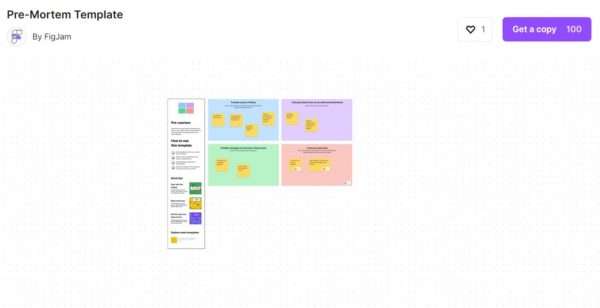
Instagantt
Instagantt template can greatly help with project premortem. It’s online software that can help plan, conduct, and store the information gathered during the meetings so that it can be reviewed later.
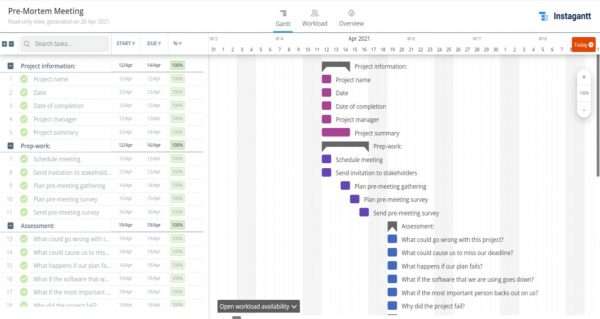
Lucidspark
Identify ways a project could fail by brainstorming before the project fails. Eliminate project failure by using this Lucidspark premortem template.
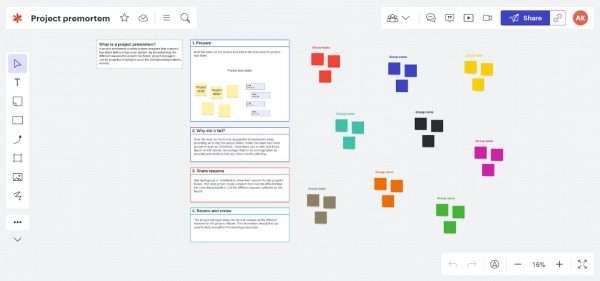
Invision
InVision is a platform that empowers companies to collaborate. This template will enable you to create collaborations across geographies and teams for proven business results and improved market speed.
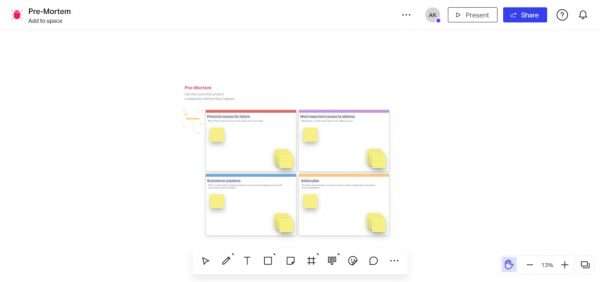
Whiteboards
Determine incidents that might happen in your project if you scale the project rapidly. With this premortem template, you can complete an analysis of incidents and prevent issues.
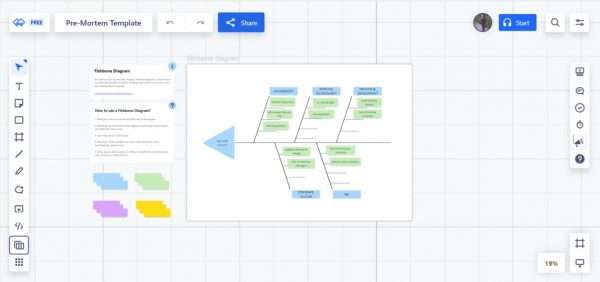
Notion Pre-Portem Template
Use this Notion template for project risk documentation and to have an action plan if the project goes wrong.
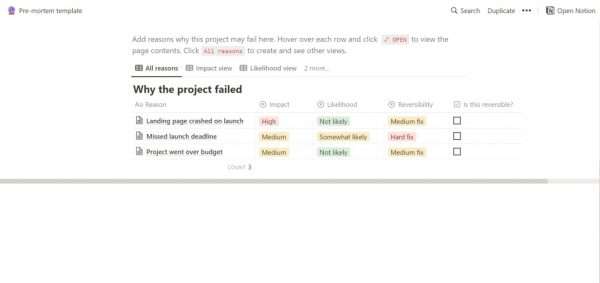
Almanac Pre-Moretem Template

The objective of this template is to identify the pitfalls in the next project cycle and establish a plan for the most likely ones.
Pre-mortem Template Excel
Pre-mortem best practices
You must consider a few factors while conducting a premortem to optimise the steps defined above, including:
- Be specific and don’t generalise to support the reasoning for project failures.
- Don’t use meetings to try to score settle or to air grievances.
- Make sure that the document is at an easily accessible location and can be found easily. This will help the team members to stay updated with document changes.
- Add action items to the virtual board or project board where the progress can be tracked easily.
- Revise and review to ensure awareness of project risks and development of solutions.
Premortem FAQs
Who created the premortem?
The premortem was developed by Gary in 2007 as a method of risk assessment. This method is used widely in the management and business domains.
What is the first step of a project premortem?
The first step of a project premortem is to enable the participants to create a list of problems that could affect the project outcomes. This results in items to efficiently and effectively address.
What is a post-mortem meeting?
A premortem meeting is one in which the project team imagines what might cause a project to fail. The team creates a plan to prevent obstacles and increase the chances of project success.
What happens next after the premortem?
A premortem enables you to understand the reasons behind project failure and prevents risks. Once the premortem is done, all that is left is running the project.

